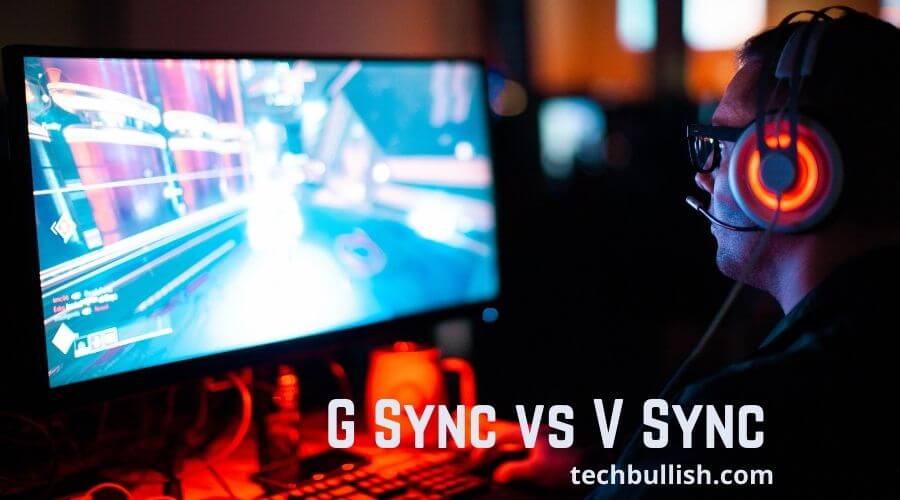These technologies are very much commonly heard if you are in gaming.
However, suppose you have a good graphics card with High FPS and a different frequency of rendering.
In that case, you may see effects like screen tearing and stuttering during gaming.
To solve the sync issue between your GPU and monitor, G-Sync and VSync was developed.
If you are looking for a comparison of G-Sync vs VSync, then this is the right post.

G-Sync vs VSync
| G-Sync | VSync | |
| Made by | Nvidia | – |
| Screen tearing problem | Solves | Solves |
| Stuttering problem | Solved by G-Sync | Not solved by VSync |
| Input Delay | No, there is no input delay | Yes input delay is there |
What is G-Sync?
G Sync is a technology for computer monitors to enable sync between the monitor with GPU to enable stutter-free and tear-free high-quality graphics during gameplay.
With G-Sync, the games feel smooth and highly remarkable to play even at high resolution and a high frame rate.
You can read in detail about what is G-Sync here.
G-Sync Tiers
G-Sync Compatible
The monitors with G-Sync are Compatible and solve the stutter and tearing of images during the gameplay.
This is the basic technology that would resolve the common problem during the rendering of high FPS games.
G-Sync
G-Sync monitors offer all the benefits of G-Sync compatibility and reduce the input latency essential in FPS games.
G-Sync Ultimate
G-Sync Ultimate is the most premium offering of the G-Sync tier.
This type of G-Sync has HDR support to render crisp colors and resolution during gaming.
Your experience would be cinematic and smoother with this ultimate tier.
What is VSync?
VSync is also known as Vertical Sync. This technology for monitors was devised because the GPU was going at higher frame rates, whereas the monitors were limited to a lower framerate.
The VSync technology solves the problem by lowering the Frame rate delivered by the Graphics card to match the monitor.
This helps to solve the Frame synchronization issue that results in tearing during gaming.
You can read in detail about what is Vsync here.
The advanced form of VSync
What is Adaptive VSync?
Adaptive VSync is a significant enhancement or improvement from Nvidia that solves the input lag issues. The Adaptive VSync looks into the monitor’s refresh rate.
Then it monitors if the GPU providing the refresh rate during the game is greater than the monitor refresh rate or not.
If your monitor refresh rate matches the gaming refresh rate, then the VSync would remain off.
When the GPU’s refresh rate during the game exceeds the monitor refresh rate, it will turn on the VSync on the monitor.
It turns off the VSync during the lower refresh rate games.
It prevents Vsync from causing the input lag, which we commonly see when playing at a higher refresh rate with VSync.
What is Fast Sync?
The following enhancement to the Adaptive VSync is the Fast Sync, and Nvidia also does it.
When the game refresh rate is high, and the monitor refresh rate is lower than the VSync would buffer the extra frames provided by the GPU and wait for the monitor to render.
VSync causes input lag till the time the frames are buffering and waiting to get rendered.
In Fast Sync, NVidia modified the buffering to triple buffering and picked the best frame data.
So, decrease the lag thrice as compared to the Adaptive sync.
What is Enhanced Sync?
Now AMD has enhanced the Fast Sync even further, and you can use it only if you have AMD Radeon Graphics cards to play games.
With the enhanced V Sync, the VSync technology turns off in case of any performance drop and hence is very much consistent during gaming.
My view on G-Sync vs VSync
VSync comes at no extra cost to you. So, if you want to get a good gaming experience in a basic setup, then VSync is the way to go.
If you are serious about gaming and even play competitive games where performance is a must, then G-Sync would be better than VSync. G-Sync would perform more reliably than VSync for any high graphics games.
G-Sync or VSync: Which One Should you choose?
On the one hand, G-Sync is a variable refresh rate technology that allows your monitor to dynamically adjust its refresh rate to match the frame rate of your graphics card.
On the other, VSync is a traditional display technology that synchronizes the refresh rate of your monitor with the frame rate of your graphics card. So, which one is better?
The answer, unfortunately, is that it depends. If you’re a competitive gamer who is looking for every possible advantage, then G-Sync is probably the way to go.
The variable refresh rate can help reduce screen tearing and input lag, giving you a slight edge over your opponents.
However, G-Sync comes at a premium, both in terms of price and power consumption.
If you’re more of a casual gamer or simply don’t want to spend the extra money on a G-Sync monitor, then VSync is a perfectly viable option. It’s been around for longer, is more widely supported, and is generally less expensive.
Plus, if you’re using a high-end graphics card, you’re likely already getting high frame rates, so the benefits of G-Sync may be less noticeable.
At the end of the day, the choice between G-Sync and VSync comes down to personal preference.
If you’re looking for the absolute best gaming experience, G-Sync is the way to go. But if you’re more concerned about cost or power consumption, then VSync is a perfectly reasonable option.
Conclusion
Let’s conclude the post on G-Sync vs VSync!
Here I discussed the two different technologies for your gaming monitor, G-Sync and the other VSync.
I would recommend going for the G Sync from Nvidia as the technology is stable and mature enough to give a premium gaming experience to the gamer.
If you like G-Sync, then you can check the comparison between G-Sync vs FreeSync.

I’m Anirban Saha, Founder & Editor of TechBullish. With a B.Tech in Electronics and Communication Engineering, and 6+ years of experience as a software developer, I have expertise in electronics, software development, gadgets, and computer peripherals. I love sharing my knowledge through informational articles, how-to guides, and troubleshooting tips for Peripherals, Smart TVs, Streaming Solutions, and more here. Check Anirban’s Crunchbase Profile here.
